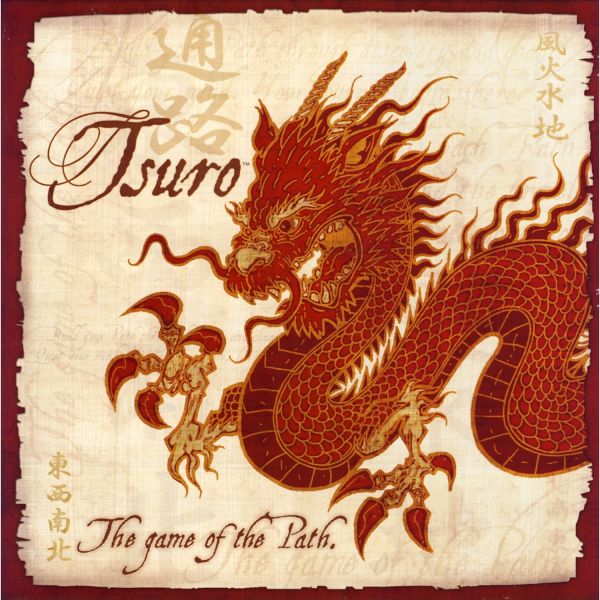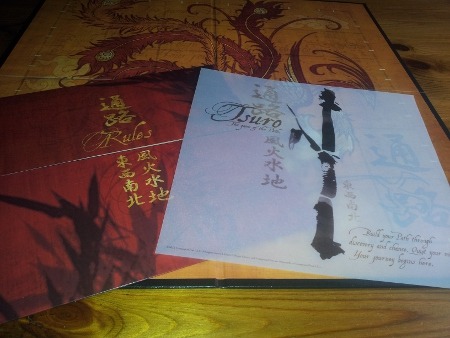 |
| Image: casualgamerevolution.com |
Players:
2-8
Duration: 15
minutes
Style: tile-based,
family game
Year: 2004
Price: 30$
Designer: Tom McMurchie
Publisher: Calliope games
Publisher: Calliope games
For those who like dragons...
 |
| Image: boardgamegeek.com |
...and for those who don't like long and complicated rules. Tsuro – the Game of the Path is a quick elimination game with simple mechanics that's good for every type of player. Designed by Tom McMurchie and published first by WizKids, it is stripped of scoring and multitasking, assigning the player with one job only: keeping his dragon flying till the end of the game.
Although this is a light game you will need a fair share of strategy if you are to avoid being cornered between dead ends. Dragons are constantly on the move, so creating a path while escaping collisions with one another, while at the same time avoiding to get off the board, can get pretty tricky to manage. Naturally, the difficulty increases the more players are around the table. The more the merrier, so it goes.
Very basic basics
Tsuro only needs to be learned once, and can easily be played without a mock match first. For preparation, every player gets a dragon gamepiece which is placed at one of the lines marking the beginning of a path, at the edges of the square board. There is no right or wrong order to start the placing, as there is no right or wrong place. After the starting points are selected, players are dealt 3 tiles which will constitute their hand. The remaining tiles are to be kept face down and used as deck.
The player's turn has only three sequencial actions:
1 - Placing a tile in front of the player's dragon
2 - Move every dragon adjacent to this tile toward the end of its new path. It doesn't matter if the dragon has to step on previously placed tiles, for the movement only stops when the dragon has no more path in front of it.
3 - The active player draws a new tile from the deck, if there's still one
In the movement phase of the turn, any dragon that gets led to the edge of the board is taken off the game. Similarly, dragons that collide are taken off as well, regardless of which dragon was moving. The tiles of these players go back to the deck. Whichever dragon is the last one standing wins. Should it happen that the last players are eliminated at the same time, these are considered the winners.
Thumbs up
The first thing Tsuro really delivers is the look. Everything in this game is dropdead gorgeous - the box, the thin translucent paper with the title on it, the board... Even the bloody rulebook is beautiful! I mean, have you looked at it? It has kanji on it and opens in the middle! Every tile is unique and creates intricate patterns on the board as the game progresses. It is, without any doubt, a collector's dream.
 |
| Image: boardgamegeek.com |
Nevertheless, I think the strongest argument in favor of Tsuro is not any of the above points. It is the basic rules that make it fast to understand. Skip all the 'wait, how was this played again?' and 'I don't get it, I'll just watch' - regardless of age, you can get everyone started right away. Therefore, Tsuro is surprisingly versatile. Families can play it together, from children to people on tight schedules. It can be enjoyed in parties as well as in pubs or cafes. And, even though simplicity can make Tsuro fall short at times, the fact that it's not very demanding feels refreshing enough even after a very tough day.
Last, but not least, not every game allows 8 players to join in at once. It's terrible when you have just one too many for an evening of gaming, right? Taking turns or teaming up is alright with most games, but no one will say no to playing on their own once in a while.
...Meh
Now, you must be thinking: "Dude, it has dragons in it. What's there not to like?". While Tsuro is without any doubt a very fun game to play, I don't think there's anyone out there who would consider it the best game ever. There are times when simplicity is welcome, and there are times when it is not.
 |
| Image: 4vp.tumblr.com |
One has to bear in mind that Tsuro is optimized for more than 2 players. Albeit it can be played with just the two, the typical two player game is just dragons running away from eachother until one's luck runs out. Since all tiles must be placed in front of a dragon, connected to the previous path, and that dragon started at the edge of the board, by the end of the game nearly every path is connected to the edges. So, one of the players must necessarily be sent off the board, usually the player which started first, or the one with worse tiles.
This means the worse flaw in Tsuro is its lack of a finishing element. With good players and well dealt tiles, it still
comes down to who lasts longer. When there are no tiles left it’s only a matter
of time. I’ve come to notice that
whenever a game ends like this I want to play more and more until there’s an
epic match of Tsuro. And great matches like that don't come often, unless you get more people to play with you.
Spicin' it up!
Every game that gets awarded that special frequently-played spot deserves a bit of tweaking to make it different. Most of them even get their rules changed a bit after years of playing. I've never known anyone who plays Scrabble by the original rules, and the same goes for many other classics.
All in all, Tsuro has the potential to become either a family game or that one game you have for time-outs in the middle of more hardcore tabletop sessions; whatever the case might be, my thinking is that there are small additions that can boost the game and make it more enjoyable. Without further ado, here are my suggested house rules.
Tsuro race edition: as I've said before, any game of Tsuro that lasts up to the last six tiles or so becomes a waiting game. There are so many ways you can go when all paths are connected to an edge, so basically if no one is thrown off, it's a matter of who lasts one round longer than the others. So, we change that and time it to last less - when the deck ends, the game ends, no matter how many tiles there are in the player's hands at that point. What's more, in case there's more than one player standing then, there is no winner. Having to take out the others on a schedule will definitely make games more exciting.
Fight! Fight! Fight!: make a point system, for instance, for every dragon you throw off their path you get 2 points. The point is not to survive, but to get more points. This will get the players running after one another and will speed things up. Another way to do this is to get a betting system - decide on a number of rounds and in each one bet which position you'll finish in. Pay in mind that these house rules also work better with more players. And beware of very competitive players, cause this can turn into a very steamy game!





